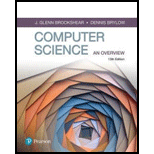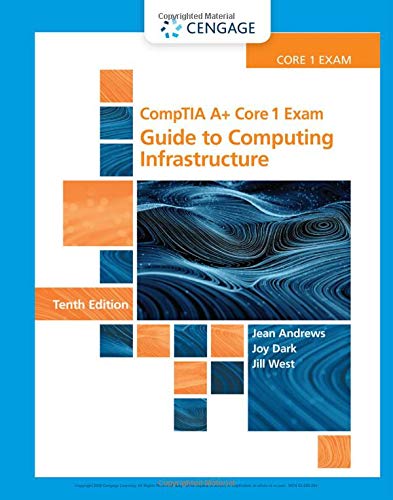
Computer Science: An Overview (13th Edition) (What's New in Computer Science)
13th Edition
ISBN: 9780134875460
Author: Glenn Brookshear, Dennis Brylow
Publisher: PEARSON
expand_more
expand_more
format_list_bulleted
Concept explainers
Question
Chapter 2, Problem 27CRP
Program Plan Intro
The program counter indicates the address of the first instruction at the same time. The instructions are fetched and program counter increase the stored value of the instruction being executed at the same time. The instructions are provided in the form of vole. The vole refers to family of stout, short-tailed rodent species found across the world.
Expert Solution & Answer
Trending nowThis is a popular solution!

Students have asked these similar questions
Describe three (3) Multiplexing techniques common for fiber optic links
Could you help me to know features of the following concepts:
- commercial CA
- memory integrity
- WMI filter
Briefly describe the issues involved in using ATM technology in Local Area Networks
Chapter 2 Solutions
Computer Science: An Overview (13th Edition) (What's New in Computer Science)
Ch. 2.1 - What sequence of events do you think would be...Ch. 2.1 - What information must the CPU supply to the main...Ch. 2.1 - Prob. 3QECh. 2.2 - Prob. 1QECh. 2.2 - In the text, JUMP instructions were expressed by...Ch. 2.2 - Is the instruction If 0 equals 0, then jump to...Ch. 2.2 - Write the example program in Figure 2.7 in actual...Ch. 2.2 - The following are instructions written in Vole...Ch. 2.2 - What is the difference between the instructions...Ch. 2.2 - Here are some instructions in English. Translate...
Ch. 2.3 - Prob. 1QECh. 2.3 - Suppose the Vole memory cells at addresses 0xB0 to...Ch. 2.3 - Suppose the Vole memory cells at addresses 0xA4 to...Ch. 2.3 - Suppose the Vole memory cells at addresses 0xF0 to...Ch. 2.4 - Prob. 1QECh. 2.4 - Prob. 2QECh. 2.4 - Prob. 3QECh. 2.4 - a. Suppose you XOR the first 2 bits of a string of...Ch. 2.4 - Prob. 5QECh. 2.4 - Prob. 6QECh. 2.4 - Prob. 7QECh. 2.4 - Prob. 8QECh. 2.4 - Prob. 9QECh. 2.4 - Prob. 10QECh. 2.4 - Using Vole machine language (Appendix C), write a...Ch. 2.4 - Prob. 12QECh. 2.5 - Prob. 1QECh. 2.5 - Prob. 2QECh. 2.5 - Prob. 3QECh. 2.6 - The hypotenuse example script truncates the sides...Ch. 2.6 - Prob. 2QECh. 2.6 - The Python built-in function str () will convert a...Ch. 2.6 - Use the Python built-in bin () to write a script...Ch. 2.6 - Prob. 6QECh. 2.7 - Referring back to Questions 3 of Section 2.3, if...Ch. 2.7 - Prob. 2QECh. 2.7 - Suppose there were two central processing units...Ch. 2 - a. In what way are general-purpose registers and...Ch. 2 - Answer the following questions in Vole machine...Ch. 2 - Prob. 3CRPCh. 2 - What is the value of the program counter in the...Ch. 2 - Prob. 5CRPCh. 2 - Prob. 6CRPCh. 2 - Prob. 7CRPCh. 2 - Suppose a machine language is designed with an...Ch. 2 - Translate the following instructions from English...Ch. 2 - Rewrite the program in Figure 2.7 assuming that...Ch. 2 - Classify each of the following Vole instructions...Ch. 2 - Prob. 12CRPCh. 2 - Prob. 13CRPCh. 2 - Suppose the memory cells at addresses 0x00 through...Ch. 2 - Suppose the memory cells at addresses 0x00 through...Ch. 2 - Suppose the memory cells at addresses 0x00 through...Ch. 2 - Suppose the memory cells at addresses 0x00 through...Ch. 2 - Prob. 18CRPCh. 2 - If the Vole executes an instruction every...Ch. 2 - Prob. 20CRPCh. 2 - Prob. 21CRPCh. 2 - Prob. 22CRPCh. 2 - Prob. 23CRPCh. 2 - Write a program in Vole to compute the sum of...Ch. 2 - Prob. 26CRPCh. 2 - Prob. 27CRPCh. 2 - Suppose the following program, written in Vole, is...Ch. 2 - Summarize the steps involved when the Vole...Ch. 2 - Summarize the steps involved when the Vole...Ch. 2 - Summarize the steps involved when the Vole...Ch. 2 - Suppose the registers 0x4 and 0x5 in the Vole...Ch. 2 - Prob. 33CRPCh. 2 - Prob. 34CRPCh. 2 - Prob. 35CRPCh. 2 - Prob. 36CRPCh. 2 - Prob. 37CRPCh. 2 - Prob. 38CRPCh. 2 - Prob. 39CRPCh. 2 - Prob. 40CRPCh. 2 - Prob. 41CRPCh. 2 - Prob. 42CRPCh. 2 - a. What single instruction in the Vole machine...Ch. 2 - Write a Vole program that reverses the contents of...Ch. 2 - Write a Vole program that subtracts the value...Ch. 2 - Prob. 46CRPCh. 2 - Suppose a person is typing forty words per minute...Ch. 2 - Prob. 48CRPCh. 2 - Suppose the Vole communicates with a printer using...Ch. 2 - Write a Vole program that places 0s in all the...Ch. 2 - Prob. 51CRPCh. 2 - Prob. 52CRPCh. 2 - Suppose you are given 32 processors, each capable...Ch. 2 - Prob. 54CRPCh. 2 - Prob. 55CRPCh. 2 - Describe how the average of a collection of...Ch. 2 - Write and test a Python script that reads in a...Ch. 2 - Write and test a Python script that reads in a...Ch. 2 - Prob. 59CRPCh. 2 - Suppose a computer manufacturer develops a new...Ch. 2 - Prob. 2SICh. 2 - Prob. 3SICh. 2 - Prob. 4SICh. 2 - Suppose a manufacturer produces a computer chip...Ch. 2 - Prob. 6SICh. 2 - Prob. 7SICh. 2 - Prob. 8SI
Knowledge Booster
Learn more about
Need a deep-dive on the concept behind this application? Look no further. Learn more about this topic, computer-science and related others by exploring similar questions and additional content below.Similar questions
- For this question you will perform two levels of quicksort on an array containing these numbers: 59 41 61 73 43 57 50 13 96 88 42 77 27 95 32 89 In the first blank, enter the array contents after the top level partition. In the second blank, enter the array contents after one more partition of the left-hand subarray resulting from the first partition. In the third blank, enter the array contents after one more partition of the right-hand subarray resulting from the first partition. Print the numbers with a single space between them. Use the algorithm we covered in class, in which the first element of the subarray is the partition value. Question 1 options: Blank # 1 Blank # 2 Blank # 3arrow_forward1. Transform the E-R diagram into a set of relations. Country_of Agent ID Agent H Holds Is_Reponsible_for Consignment Number $ Value May Contain Consignment Transports Container Destination Ф R Goes Off Container Number Size Vessel Voyage Registry Vessel ID Voyage_ID Tonnagearrow_forwardI want to solve 13.2 using matlab please helparrow_forward
- a) Show a possible trace of the OSPF algorithm for computing the routing table in Router 2 forthis network.b) Show the messages used by RIP to compute routing tables.arrow_forwardusing r language to answer question 4 Question 4: Obtain a 95% standard normal bootstrap confidence interval, a 95% basic bootstrap confidence interval, and a percentile confidence interval for the ρb12 in Question 3.arrow_forwardusing r language to answer question 4. Question 4: Obtain a 95% standard normal bootstrap confidence interval, a 95% basic bootstrap confidence interval, and a percentile confidence interval for the ρb12 in Question 3.arrow_forward
arrow_back_ios
SEE MORE QUESTIONS
arrow_forward_ios
Recommended textbooks for you
 Systems ArchitectureComputer ScienceISBN:9781305080195Author:Stephen D. BurdPublisher:Cengage Learning
Systems ArchitectureComputer ScienceISBN:9781305080195Author:Stephen D. BurdPublisher:Cengage Learning A+ Guide to Hardware (Standalone Book) (MindTap C...Computer ScienceISBN:9781305266452Author:Jean AndrewsPublisher:Cengage Learning
A+ Guide to Hardware (Standalone Book) (MindTap C...Computer ScienceISBN:9781305266452Author:Jean AndrewsPublisher:Cengage Learning A+ Guide To It Technical SupportComputer ScienceISBN:9780357108291Author:ANDREWS, Jean.Publisher:Cengage,
A+ Guide To It Technical SupportComputer ScienceISBN:9780357108291Author:ANDREWS, Jean.Publisher:Cengage, Principles of Information Systems (MindTap Course...Computer ScienceISBN:9781285867168Author:Ralph Stair, George ReynoldsPublisher:Cengage Learning
Principles of Information Systems (MindTap Course...Computer ScienceISBN:9781285867168Author:Ralph Stair, George ReynoldsPublisher:Cengage Learning Comptia A+ Core 1 Exam: Guide To Computing Infras...Computer ScienceISBN:9780357108376Author:Jean Andrews, Joy Dark, Jill WestPublisher:Cengage Learning
Comptia A+ Core 1 Exam: Guide To Computing Infras...Computer ScienceISBN:9780357108376Author:Jean Andrews, Joy Dark, Jill WestPublisher:Cengage Learning C++ for Engineers and ScientistsComputer ScienceISBN:9781133187844Author:Bronson, Gary J.Publisher:Course Technology Ptr
C++ for Engineers and ScientistsComputer ScienceISBN:9781133187844Author:Bronson, Gary J.Publisher:Course Technology Ptr

Systems Architecture
Computer Science
ISBN:9781305080195
Author:Stephen D. Burd
Publisher:Cengage Learning

A+ Guide to Hardware (Standalone Book) (MindTap C...
Computer Science
ISBN:9781305266452
Author:Jean Andrews
Publisher:Cengage Learning

A+ Guide To It Technical Support
Computer Science
ISBN:9780357108291
Author:ANDREWS, Jean.
Publisher:Cengage,

Principles of Information Systems (MindTap Course...
Computer Science
ISBN:9781285867168
Author:Ralph Stair, George Reynolds
Publisher:Cengage Learning

Comptia A+ Core 1 Exam: Guide To Computing Infras...
Computer Science
ISBN:9780357108376
Author:Jean Andrews, Joy Dark, Jill West
Publisher:Cengage Learning

C++ for Engineers and Scientists
Computer Science
ISBN:9781133187844
Author:Bronson, Gary J.
Publisher:Course Technology Ptr